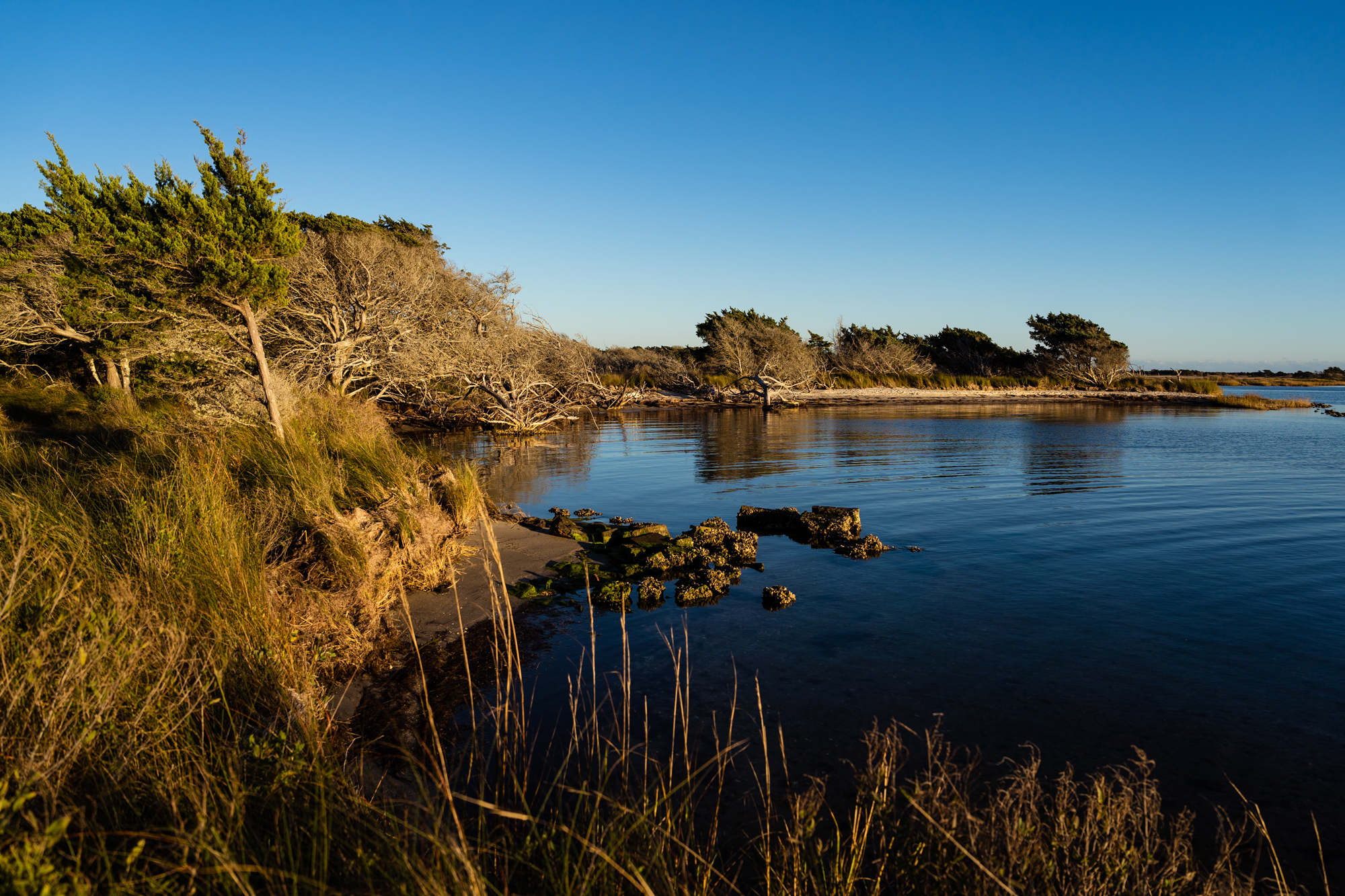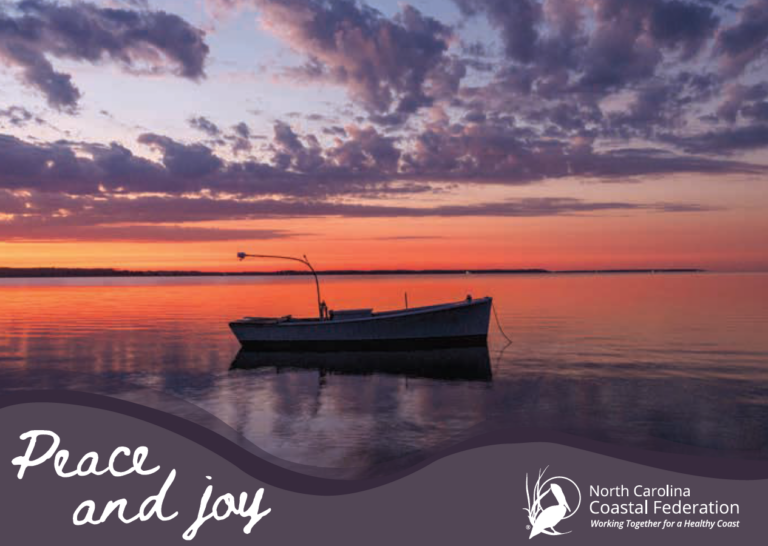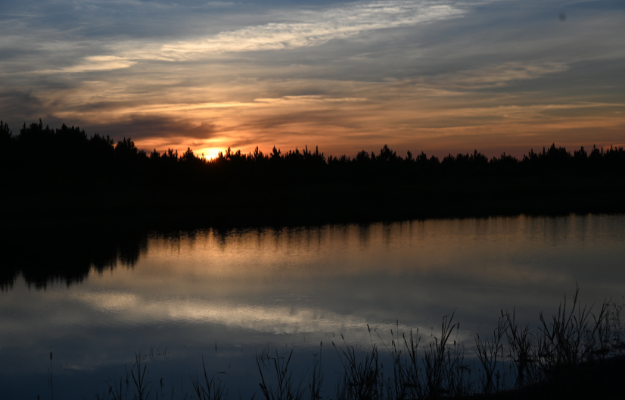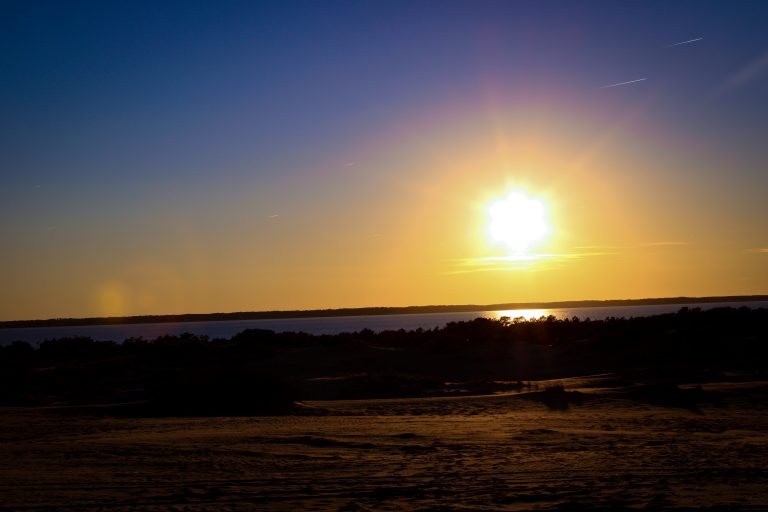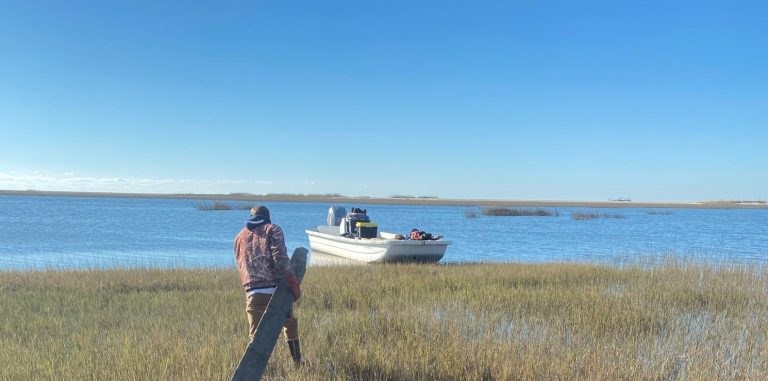Since 1982, the North Carolina Coastal Federation has worked with people to safeguard the coastal rivers, creeks, sounds, and beaches of North Carolina.
Todd Miller formed the nonprofit organization in 1982. Although the Coastal Area Management Act had been in effect since 1974, there was a need for a clearer vision for long-term coastal management.
Soon after it formed in 1982, the Federation rallied fishermen, environmentalists, and scientists to oppose a proposal to strip-mine 120,000 acres of peat bogs between the Albemarle and Pamlico sounds. The project gained national attention, including coverage on the CBS Evening News and PBS’s MacNeil-Lehrer Report. The proposal was defeated in 1984, and the federation then worked for the passage of state rules that effectively prohibited large-scale peat mining. Most of the areas that were formerly targeted for peat mining are now permanently preserved in national wildlife refuges.
Recent Highlights
Saving Great Places
Glenn Blackburn, professor emeritus of history at the University of Virginia’s College at Wise, completed a history of the North Carolina Coastal Federation based upon hundreds of interviews he conducted with people who have been key players in shaping our coast. We are proud to offer an online version of Blackburn’s book, Saving Great Places, a historical account of the men and women who fought to protect and the coastal waters of North Carolina.
Historical Highlights
2018 Highlights
- The Federation worked with partners to complete watershed restoration plans for Lake Mattamuskeet, Pine Knoll Shores, and the Cape Fear River.
- The Federation designed a 4,800-acre wetland restoration project at North River Wetlands Preserve.
- The Federation prevented 7,193,268 gallons of polluted stormwater from entering our coastal waters through retrofit projects in Wrightsville Beach, Wilmington, Swansboro, Elizabeth City, and Pine Knoll Shores.
- The Federation convened a North Carolina Living Shoreline Steering Committee in partnership with the Albemarle-Pamlico National Estuary Partnership to advance and promote the use of living shorelines.
- The Federation succeeded in improving and simplifying the permitting for living shorelines.
- educated hundreds of property owners about living shorelines.
- Installed 3,098 feet (0.6 miles) of living shorelines at 13 public and private locations and planted 16,310 salt marsh grasses.
- Conducted several living shorelines training for marine contractors, Federal Highway Administration/NCDOT engineers, and planners, and provided the keynote address at the 2nd Annual National Living Shoreline Technology Transfer Conference in California.
- The Federation restored 12 acres of oyster reef at the Swan Island Oyster Sanctuary in the mouth of the Neuse River, at Carolina Beach State Park, at the Wanchese Marine Industrial Park, and through living shorelines incorporating oyster habitat.
- The Federation worked with the N.C. Division of Marine Fisheries to plant 47.63 acres of oyster cultch that is available for harvest.
- The Federation coordinated a rigorous 18-month collaborative process involving scientists, the public, legislators, fishermen, oyster growers, economists, tourism, and other stakeholders to develop the North Carolina Shellfish Mariculture Strategic Plan for growing the shellfish farming industry along our coast.
- The Federation promoted the development of a statewide state-of-the-art water quality monitoring program for emerging contaminants, including GenX, in the surface waters of N.C.
- The Federation informed the public about swimming advisories and shellfish closures after Hurricane Florence until coastal waters were at safe levels. The Federation also successfully advocated for state funding to help our coast recover in the wake of Hurricane Florence.
- The Federation opposed the development of offshore oil and gas and seismic testing through public events, and comment letters and worked with a coalition of eight environmental organizations legally challenging the authorization of seismic surveys.
- The Federation opposed terminal groins and recognized the Town of Holden Beach with a Pelican Award for abandoning their plans for a terminal groin. In addition, the federation submitted a comment letter on the proposed Figure Eight Island groin.
- The Federation conducted 15 cleanups coastwide to remove 635,245 pounds of marine debris.
- The Federation worked with 76 fishermen coastwide to collect 3,496 crab pots from the state’s sounds and rivers.
- The Federation engaged 13,261 students and adults through field programs, events, presentations, workshops, and our intensive 12-week summer internship program, reached 26,804 people through communications (email, Our Coast, social media), and provided 8 continuing education training.
- The Coastal Review Online provided outstanding coverage of the coast, reaching 327,532 readers, producing over 1,000 stories, and winning 25 awards from the N.C. Press Association (including eight First Place Awards).
2017 Highlights
- The Federation worked with the towns of Swansboro and Beaufort to develop watershed restoration plans to reduce polluted runoff in the coastal communities.
- The Federation worked with Oak Island and completed a series of StreetSide stormwater retrofits to reduce the volume of runoff from town roads by over 25,000 gallons during a 24-hour storm event.
- The Federation completed a series of stormwater reduction projects in the White Oak watershed including a rain garden, water control structures, check dams, rain barrels, and other techniques to runoff by more than 61,000 gallons during the 1-year, 24-hour storm.
- The Federation constructed 8.8 acres of salt marsh and 3,500 linear ft. of tidal creek at the headwaters of Williston Creek at the North River Wetlands Preserve.
- The Federation planted 35 acres of Atlantic white cedars in Hyde County as part of the U.S. Fish and Wildlife Service cost-share program.
- The Federation worked with 72 commercial fishermen to collect 4,304 lost crab pots – the greatest number of pots removed during the ‘no-potting period’ since 2004.
- The Federation removed 298.53 tons of marine debris from 13 sites coastwide with the help of 134 volunteers while also taking a holistic approach to the issue through a coast-wide assessment and reduction strategy.
- The Federation launched our new cost-share program to promote living shorelines and installed 2,598 linear feet (1/2 mile) of living shorelines at thirteen sites (15,946 bags of recycled oyster shells and 7,352 salt marsh grasses)
- The Federation worked with NOAA representatives in the fall of 2017 to finalize the regional general permit that will be issued by the Wilmington District for living shorelines.
- The Federation restored 16 acres of oyster reef at Swan Island and Carolina Beach State Park.
- The Federation worked for improvements in the New Hanover County Special Use Permit
- The Federation opposed Offshore Oil and Gas Development through grassroots efforts, winning support from new community groups, commercial and recreational fishermen, and N.C. Governor Roy Cooper.
- The Federation launched a campaign to inform the public about the contamination of drinking water in the greater Wilmington area by GenX and engage scientists and state leadership on a comprehensive solution
- The Federation successfully opposed terminal groins and hardened structures at Lockwood Folly Inlet, Rich Inlet, and New Topsail Inlet
- The Federation participated in the Navassa EPA Superfund community initiative to assist the town of Navassa in federal efforts to reclaim and develop the superfund site for the town.
- The Federation reached nearly 250,000 people and won 12 press awards in 2017 via Coastal Review Online.
- The Federation worked with 61 education partners and 1,052 volunteers.
- The Federation’s education programs reached 5,912 students and 176 teachers with hands-on environmental activities, with nearly 60% of the students drawing from underserved or Title 1 schools or groups, including River City YouthBuild, BRC Youth Enrichment Zone, DREAMs, Boys & Girls Clubs, and YWCA.
- The Federation engaged professionals and the public with more than 20 tours and trainings.
2016 Highlights
- The Federation helped lead the Stop Titan coalition, which successfully led grassroots opposition to Titan America’s plan to develop a coal-fired cement plant in New Castle Hayne. Titan America announced in March 2016 that it was abandoning its plans.
- The Federation and other organizations successfully led opposition to offshore oil drilling off the North Carolina coast. The Bureau of Ocean Energy Management announced in March 2016 that it was not going to include the Atlantic coast in its 2017-22 offshore oil and gas leasing plan. It cited grassroots opposition from coastal residents and local governments as one of its reasons for not moving forward.
- The Manteo office relocated to the Wanchese Marine Industrial Park, where staff now work alongside commercial fishermen, recreational boat builders, and fishing suppliers.
- The Federation reached more than 170,000 people. It engaged 1,007 volunteers, educated 4,186 students, and informed 10,745 people through presentations, programs, and workshops.
2010-2015 Highlights
2015
- The Federation co-hosted the North Carolina Oyster Summit in Raleigh in addition to eight other workshops and summits on offshore oil, stormwater, living shorelines, and more.
- The Federation employed 40 commercial fishermen to remove 1,368 lost crab pots in the Outer Banks region.
- The Federation restored 1,025 acres of habitat.
- Federation staff educated 2,432 students and engaged 1,202 volunteers, and it reached 22,590 people.
2014
- The Federation opened the Fred and Alice Stanback Coastal Education Center, our southeast office in Wrightsville Beach. All three of our offices now have permanent homes.
- The Federation spearheaded a highly successful Low Impact Development Summit, which hosted developers, engineers, elected leaders, and federal and state agency staff all affirming their commitment to LID for improving water quality.
- The Federation paid commercial fishermen to collect derelict and abandoned crab pots in the Pamlico Sound as part of a Marine Debris project funded by the National Oceanic and Atmospheric Administration and the North Carolina Sea Grant.
- More hydrologic restoration work was completed in the 42,500-acre Mattamuskeet Drainage Association in Hyde County, bringing us closer to restoring the hydrology to pre-ditching and draining levels.
- The Federation engaged 966 volunteers who donated 13,662 hours; 2,175 students who participated in education programs; and 307,389 people who were educated through education and outreach programs (the increased education and outreach numbers are due to the 240,000 viewership of the CBS special Eyes on Wilmington).
2013
- The Federation’s daily news service, the Coastal Review Online, became a member of the North Carolina Press Association. The Federation is the only non-profit awarded this honor, which recognizes the objectivity of its reporting.
- The Federation closed on the easement for the final tract of land at North River Farms, initiating the last phase in the 6,000-acre wetland restoration. Shellfish waters adjacent to the restoration changed from closed to conditionally approved open.
- The Federation completed another 1,200 acres of hydrologic restoration on the Mattamuskeet Drainage Association in Hyde County. Working with farmers, the federation is removing agricultural drainage from the Long Shoal River and Pamlico Sound with the goal of restoring historical oyster beds and shellfishing.
- The Federation worked with partners to design and promote STORM EZ, a tool that allows developers, builders, and others to calculate stormwater management amounts for permitting. It makes Low-Impact Development much easier to use.
- The Federation released a guidebook for creating a watershed restoration plan that was approved by the state and the U.S. Environmental Protection Agency. This makes it easier, faster, and less expensive for local governments and groups to create watershed restoration plans and then direct funds to needed implementation.
- The Federation engaged 1,368 volunteers who donated 15,842 hours; 2,402 students who participated in education programs; and 23,519 people who were educated through education and outreach programs.
2012
- The Federation launched Coastal Review Online, a free, daily news service highlighting the coast’s most important issues and news.
- The Federation worked with the N.C. Division of Water Quality to develop a formal state commitment to Low Impact Development (LID) that includes ways to overcome impediments and work to promote LID educational and outreach opportunities.
- The Federation engaged 2,093 volunteers who donated 17,301 hours; 3,313 students who participated in education programs; and 18,066 people who were educated through education and outreach programs.
2011
- The Federation continued to lead the effort to stop Titan through the management of the STAN coalition by successfully engaging the community to rally against Titan. Additionally, the Federation and partners educated and empowered citizens to pressure the local commissioners to update local zoning requirements for heavy and light industries that will require Titan to apply for a Special Use Permit approval from the county.
- The Federation championed the Use of Low Impact Development (LID) by local governments, developers, and landowners with the goal of reducing stormwater runoff.
2010
- The Federation engaged 500 citizens in public meetings that discussed problems caused by terminal groins and beach hardening. No bills were passed in 2010 that allowed terminal groins. The Federation rallied members and the public to attend Hands Across the Sand – a nationwide protest of Offshore Drilling, and 1,727 people attended 18 rallies in N.C.
- The Federation surpassed 10,000 members.
2000-2009 Highlights
2009
- The Federation received a $5 million federal economic stimulus grant to construct oyster reefs for oysters and other estuarine animals and plants that will create or retain 140 jobs coast-wide.
- The Federation organized the Beach Summit, which was attended by more than 50 experts in beach science, policy, and management. The summit produced recommendations for ensuring that our beaches stay public and healthy.
2008
- The Federation offered citizens from areas around Wilmington, Morehead City, Manteo, and the Triangle an opportunity to rally outside the North Carolina State Legislative Building in Raleigh to show support for more effective rules to control polluted runoff along the coast. Meetings were arranged to ensure legislators heard all sides of the debate. Citizens had another opportunity while seated across the table from their representatives at lunch to peel shrimp and argue the need for clean water. The legislature passed tougher stormwater rules.
- The Federation’s Northeast Regional Office in Manteo was purchased, renovated, and opened.
2007
- The Federation led a campaign that resulted in the passage of the Solid Waste Management Act of 2007. The bill nixed several mega-landfills planned for the coast in low-income and minority rural communities and established new environmental protections to protect surface waters and wetlands.
2006
- Landowners on the Scuppernong River in Tyrrell County worked with the Federation to place 160 acres of wetlands and prime upland real estate in a conservation easement held by the Federation.
2005
- The Morris Landing Living Shoreline demonstration project in Onslow County was completed, including the construction of a 575-foot stone and oyster-bag sill adjacent to Stump Sound, the planting of wetland grasses, and the construction of a public pier and educational platform.
- The Federation received a grant from the N.C. Clean Water Management Trust Fund to buy much of Jones Island in the lower White Oak River. The island was for sale, and development would have increased bacterial contamination in the river. It is now being developed into an environmental education center.
2004
- The Federation received the prestigious Governor’s Conservation Achievement Award for 2004 Land Conservationist of the Year. The award was given to the Federation’s North River Farms restoration project, the largest private wetlands restoration project in North Carolina history.
- Seven schools participated in the Federation’s Student Wetland Nursery Program, cultivating plants in wetland nurseries built at schools and planting 12,500 plants to restore 3,000 feet of coastal shoreline.
2003
- The Cape Hatteras Coastkeeper® came aboard.
- The Federation saw a number of new legislative initiatives, including the “Living Shorelines” law. This bill will speed up the process and promote natural shoreline erosion control projects over chemically treated wooden bulkheads that destroy marine habitats.
- The N.C. Clean Water Management Trust Fund approved a grant to allow the Federation to buy 52 acres at Morris Landing near Holly Ridge in Onslow County. This property helps to protect the relatively unpolluted waters of Stump Sound, an extremely productive fisheries area for shellfish, shrimp, and finfish.
2002
- The Federation conducted major shoreline restoration projects at the Duke University Marine Lab on Pivers Island near Beaufort and at the North Carolina Aquarium at Pine Knoll Shores.
- The Federation’s second Coastkeeper® began work in the Cape Lookout region.
- The N.C. Department of Environment and Natural Resources held a formal dedication of Bird Island as the state’s 10th coastal reserve. The Federation and several environmental groups worked over ten years to purchase and protect the island from development.
- The Federation bought the rest of North River Farms. The Federation negotiated with three private conservation buyers to acquire 1,435 acres. They committed to providing the federation with a conservation easement on the land after it is restored by enrolling the land in the Wetland Reserve Program through USDA.
2001
- The Cape Fear Coastkeeper®, headquartered in the Wilmington field office, became the Federation’s first Coastkeeper®.
- Carteret Community College worked with the Federation, N.C. State University and others to restore its shoreline on Bogue Sound as part of a campus-wide stormwater management plan. The N.C. Clean Water Management Trust Fund approved the planning grant.
2000
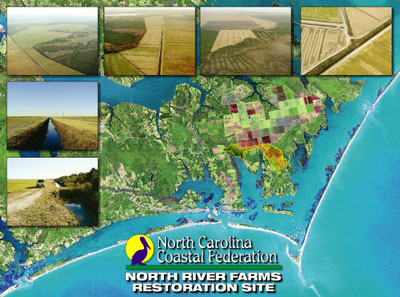
- The Wetlands Restoration Fund agreed to provide money and work with the Federation to remove a portion of a causeway to Permuda Island in Onslow County, restoring tidal wetlands in the area and increasing flushing in Stump Sound – one of North Carolina’s most productive oyster areas.
- The Federation bought 1,981 acres on North River in Carteret County with a grant from the N.C. Clean Water Management Trust Fund. The former farmland is the site of the largest wetland restoration project in the state.
1990-1999 Highlights
1999
- Using a grant from the N.C. Clean Water Management Trust Fund, the Federation helped Hammocks Beach State Park buy Huggins Island, a 110-acre developable island in the White Oak River. Later in the year, the island was incorporated into Hammocks Beach State Park and permanently protected.
- With help from the Federation, a moratorium on new hog farms and expansion of existing farms in the state was extended until 2001.
- The Federation again helped to defend the state’s ban on ocean seawalls as a third party in the Shell Island suit. The North Carolina Court of Appeals upheld the State’s ban by unanimously deciding that the ban is constitutional.
1998
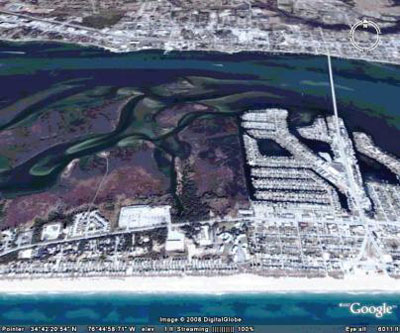
- The Federation’s education program started two major restoration projects at Hoop Pole Creek: placing oyster shells (cultch) in the creek to restore a historic oyster bed and planting over 2,000 wetland plants in the marsh to restore a heavily damaged section of the wetland.
- The state was assisted in its defense to ban sea walls when the Federation became a third party to a lawsuit between the Shell Island Resort Homeowners Association and the N.C. Coastal Resources Commission. A superior court judge dismissed the suit, but his decision was appealed.
- The Federation helped rally people to oppose Chevron USA when it announced its intention to sink a test well 30 miles off Cape Hatteras.
- With assistance from the federation, the N.C. Coastal Resources Commission proceeded with the creation of new rules to protect our shoreline along coastal rivers and sounds.
1997
- The Federation opened a field office in Wilmington.
- The Federation started the ShoreKeeper Program to encourage coastal residents to become more responsible and involved stewards of the environment.
- The Federation bought 31 acres along Hoop Pole Creek in Atlantic Beach with $2.5 million from the N.C. Clean Water Management Trust Fund. The parcel is now preserved as a nature area and nature walk.
1996
- As one of 11 regional estuary environmental groups, the Federation helped draft a federal bill by the national coalition, Restore America’s Estuaries, to restore one million acres of estuarine habitat by 2010.
- The N.C. General Assembly passed the N.C. Clean Water Management Trust Fund with the support of the Federation.
- In partnership with the Sunset Beach Taxpayers Association, the Federation succeeded in getting the state to authorize a comprehensive environmental analysis of the secondary impacts of central sewage systems along the coast.
1995
- The first annual State of the Coast Report was published and distributed to 100,000 households.
- The Federation partnered with seven other organizations from across the country to form Restore America’s Estuaries, a national coalition with the goal of restoring estuaries nationwide.
1994
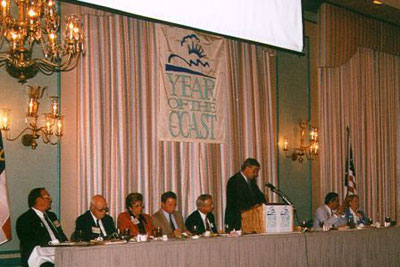
- With the state, the Federation coordinated and promoted the statewide Year of the Coast event. The yearlong event focused on the value of our coastal environment and the fundamental causes of a deteriorating coast. The work grew out of the Federation’s Seeking a Coastal Water Quality Commitment: An Agenda for Action campaign
- In partnership with the N.C. Department of Environment, Health, and Natural Resources, the Federation developed the Save Our Coast campaign to implement the recommendations that grew out of the Year of the Coast. Gov. Jim Hunt enthusiastically endorsed the recommendations.
1993
- The Federation expanded its environmental education program with improvements to the Hadnot Creek public nature trail and education center in Carteret County.
1992
- The Federation started efforts to preserve Bird Island in Brunswick County when the owner announced plans to build a mile-long bridge to the island and develop the island for houses. The Federation helped organize the Bird Island Society and continues today as a mentor to the group.
1991
- The Federation helped mobilize citizens to oppose a proposal to allow seawalls and other types of hardened structures along the beaches. After a letter-writing campaign and public hearing the N.C. Coastal Resources Commission said that strong public support for the ban had swayed the commission to reject the proposal.
1990

- Stormwater runoff rules were strengthened and better rules to regulate marina sites in shellfish waters were obtained through Federation efforts.
- The Federation took a leadership role in the state’s designation of 10 percent of coastal waters as Outstanding Resource Waters – the state’s most protective water quality classification.
- After much public pressure organized by the Federation, Gov. Jim Martin publicly opposed Mobil Oil Corporation’s proposal to make exploratory drills off the N.C. coast.
1982-1989 Highlights
1989
- Todd Miller, the Federation’s executive director at the time, accepted an invitation from Congress to testify at its water quality hearings.
- The Federation analyzed pollution from Texas Gulf Chemical Co. in Aurora and found that discharges from the company’s phosphate mining operation did not conform to federal standards. The company installed an innovative waste recycling system that dramatically reduced phosphorus and fluoride discharges to the river.
- The Federation participated in public hearings on the environmental impact study prepared for Mobil Corporation’s oil drilling exploration plan.
1988
- In partnership with other environmental groups, the Federation filed a federal lawsuit over the failure of the Army Corps of Engineers to protect 404 wetlands.
1987
- With encouragement from the Federation, Congress designated the estuaries of the Albemarle and Pamlico sounds as “National Concerns.” This designation led to the creation of the Albemarle-Pamlico Estuarine Study (APES).
- The Federation began working to ensure active citizen involvement and preparation in the APES Conservation Management Plan.
1986
- The Federation mobilized citizen support for the Division of Environmental Management’s proposed stormwater runoff rules.
1985
- A successful lawsuit was filed against the state for permitting a marina and condominiums on Hoop Pole Creek in Atlantic Beach. Eleven years later, the federation bought the property adjacent to open shellfishing. It is now permanently protected.
- With three other groups, the Federation filed a lawsuit against the N.C. Environmental Management Commission asking that three proposed Bogue Banks shopping centers require permits to discharge stormwater into Bogue Sound. The pressure eventually led to the state’s adoption of more effective rules.
1984
- The Peat Methanol Associates’ proposal to mine peat was defeated. Those wetlands formerly targeted for peat mining are now mostly preserved as national wildlife refuges.
1983
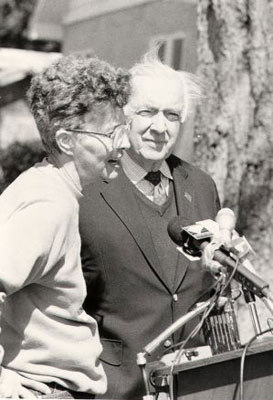

- The Federation worked with fishermen in Onslow County to halt the construction of condominiums on Permuda Island in Stump Sound. The state denied the permits three years later, and the island is now publicly owned as a natural and historic estuary preserve.
- With fishermen, environmentalists, scientists, and citizens, the Federation rallied to oppose peat mining of wetlands (photo right) between the Albemarle and Pamlico sounds. This movement gained national attention, including coverage on the CBS Evening News and PBS’s MacNeil-Lehrer Report.
1982
- The Federation was formed by Todd Miller, the first executive director, and the first staff member, in response to threats from the peat mining industry. Todd ran the organization out of his house in Ocean in Carteret County.

